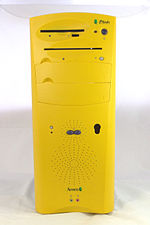Phoebe (computer)
 |
|

The case of the Acorn Phoebe 2100.
|
|
| Developer | Acorn Computers |
|---|---|
| Type | 32-bit microcomputer |
| Release date | Cancelled before launch in late 1998 |
| Introductory price | £1499 (exc VAT) in 1998 |
| Media | floppy disk, hard disk, CD-ROM |
| Operating system | RISC OS 4 |
| CPU | Intel StrongARM SA110 |
| Memory | up to 512 MiB of SDRAM |
| Display | VGA |
| Input | Keyboard, Mouse, Joystick |
| Connectivity | 2 x RS-232 serial, printer parallel |
The Phoebe 2100 (or Risc PC 2) was to be Acorn Computers' successor to the Risc PC, slated for release in late 1998. However in September 1998 Acorn cancelled the project as part of a restructuring of the company.
Processors running at 300 MHz were being sampled by Acorn in September 1998, with 360 MHz versions also expected.
In November 1996, the design of what was to become Phoebe 2100 was started. The design took into account a number of perceived weaknesses of the Risc PC design, a slow memory architecture, limited I/O capability, limited expansion, and not adhering to industry standards. To overcome these weakness a number of design objectives were created; Harness the full potential of the StrongARM CPU, support multiple processors, add support for PCI expansion, offer the best possible graphics, run existing RISC OS applications and to provide enhanced RISC OS functionality. An additional design objective of reusing the same case as the Risc PC was dropped due to power supply requirements and electrical interference problems.
To provide for these new capabilities Acorn had to design two new support chips for the system;
During 1997 and 1998 Acorn regularly took prototype and mock-up hardware to various Acorn computer shows, including Acorn World October 1997, Wakefield Acorn Spring Show May 1998 and the Acorn Southeast Show June 1998.
By May 1998 Acorn started to offer their 'Registered Developer' scheme members the chance to pre-order a pre-launch prototype for testing and development, these were offered at a £950 (ex VAT) a significant discount on the public price of £1500 (ex VAT) revealed in June.
On 15 September 1998, the first Phoebe 2100 motherboards with silicon (rather than FPGA) based IOMD2 chips were powered up. They successfully ran at the full front side bus speed of 64 MHz, and the improved performance of the video chip was also seen, however various bugs in the sound DMA were reported and general system instability was noted. As such, no shippable prototypes were yet available to send to the 'Registered Developers'.
Two days later, on 17 September 1998, the development of Phoebe 2100 was cancelled.
Development was expected to cost £2.1 million.
During the years following the release of the Risc PC, Acorn had discussed using an alternative to RISC OS as their next operating system, using TAOS or writing their own microkernel-based operating system Galileo. However for the launch of Phoebe 2100 an enhanced version of RISC OS would be developed, called RISC OS 4 (codenamed 'Ursula'). RISC OS wouldn't support the multiple processor daughter cards that had been included in the Phoebe 2100 hardware specification.
...
Wikipedia
